Experience the authentic flavors of Sichuan cuisine with this mouth-watering recipe for saliva chicken. The dish features tender juicy chicken smothered in a rich and spicy sauce that is bursting with umami, just like the one served in China.
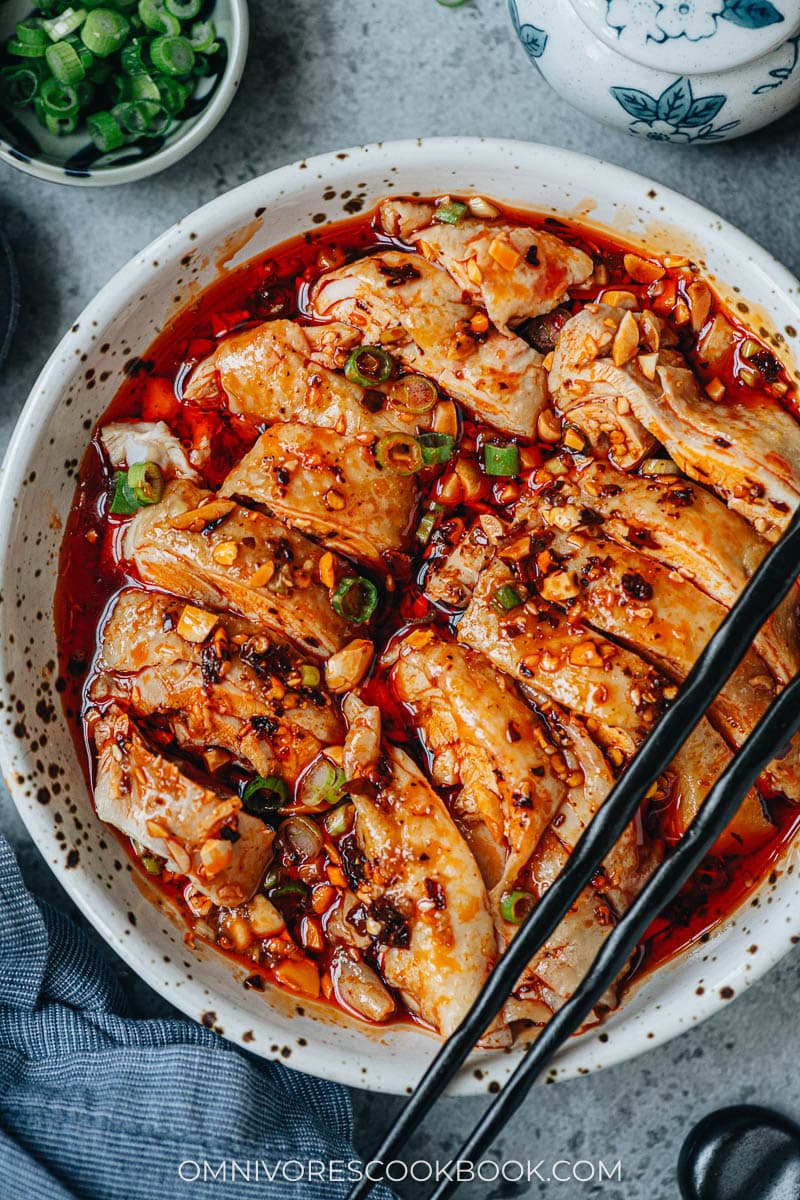
What is saliva chicken
Saliva Chicken, known as “口水鸡” (Kou Shui Ji) in Chinese, is a popular dish in Sichuan cuisine. The literal translation of its name might sound unusual to non-Chinese speakers. But in fact, the Chinese dish name means “mouth-watering chicken”, which is a more proper name for this famous dish.
Saliva chicken is highly regarded for its flavor and complexity. The dish is typically made by poaching chicken, usually a whole chicken or chicken thighs. The chicken is then cooled and cut into bite-sized pieces, then drenched in a spicy, numbing, and flavorful sauce that is savory and full of umami. The sauce wakes up your senses and makes you crave for more. If you’ve tried the dish before and want to replicate that ultra-rich flavor at home, you’ve come to the right place!
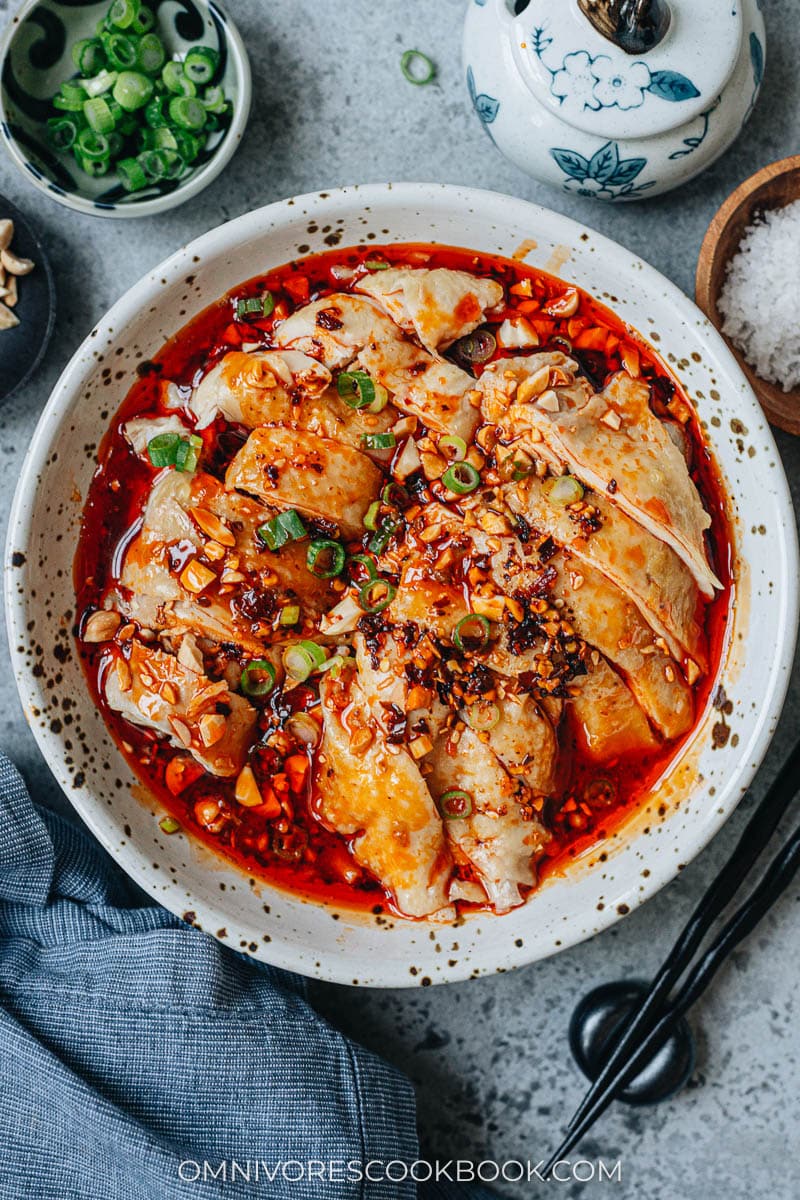
Ingredients for saliva chicken
Chili oil
The key ingredient in the dish is chili oil, which gives the dish its vibrant red color and spicy taste.
If possible, I highly recommend making chili oil at home. The homemade version is way more fragrant, fresh, and bursting with flavor. Don’t worry about it making your dish too spicy. If you choose the proper Chinese chili pepper flakesthe recipe makes an aromatic oil that is less spicy and more flavorful.
If you do not want to make chili oil at home, definitely check out the chili crisp oil by the Mala Market. Their chili oils are made in Sichuan in small batches and are very fresh. It will give your saliva chicken that authentic taste you’re looking for.
Sichuan peppercorns
Sichuan peppercorn (the red type) is another key ingredient commonly used in Sichuan cuisine. It does not taste spicy and has a citrusy taste with a numbing tingling sensation when you chew on it. It’s the secret to adding aroma to your dish that no other ingredient can replace.
You can purchase Sichuan peppercorns at Asian grocery stores, but I highly recommend these premium fresh ones from The Mala Market.
Authentic saliva chicken often uses a small touch of green Sichuan peppercorn oil for another layer of flavor. Like the red Sichuan peppercorns, the green peppercorns also give you a numbing sensation with a grassy undertone. I love the Green Peppercorn Oil by 50 Hertz. But feel free to skip this if you don’t have it on hand.
Chinese sesame paste (sesame paste)
Chinese sesame paste gives the sauce its creamy texture and a nutty taste. Different from tahini, Chinese sesame paste uses roasted white sesame seeds for a warmer taste and a darker color. When you purchase sesame paste, try to find the type that uses 100% sesame seeds. It tastes better than the ones using both sesame seeds and peanuts.
If you do not have this ingredient, the best alternative is unsalted natural peanut butter.
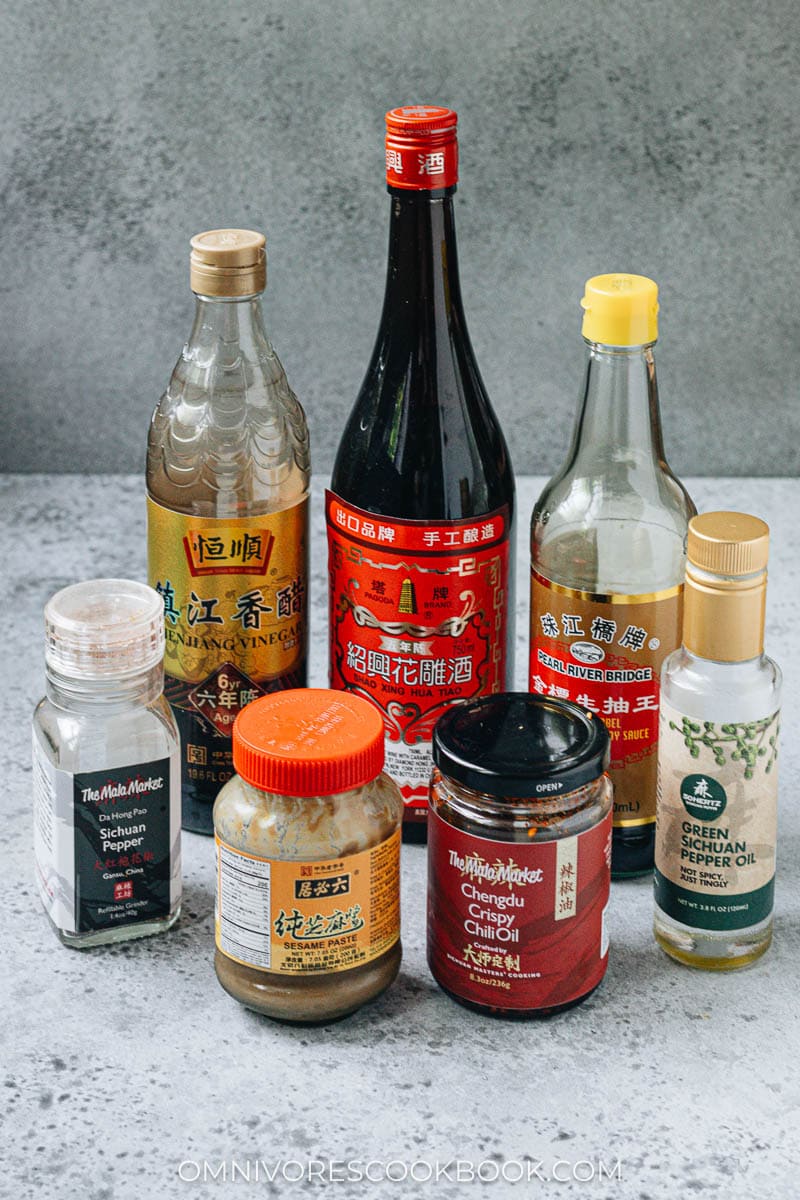
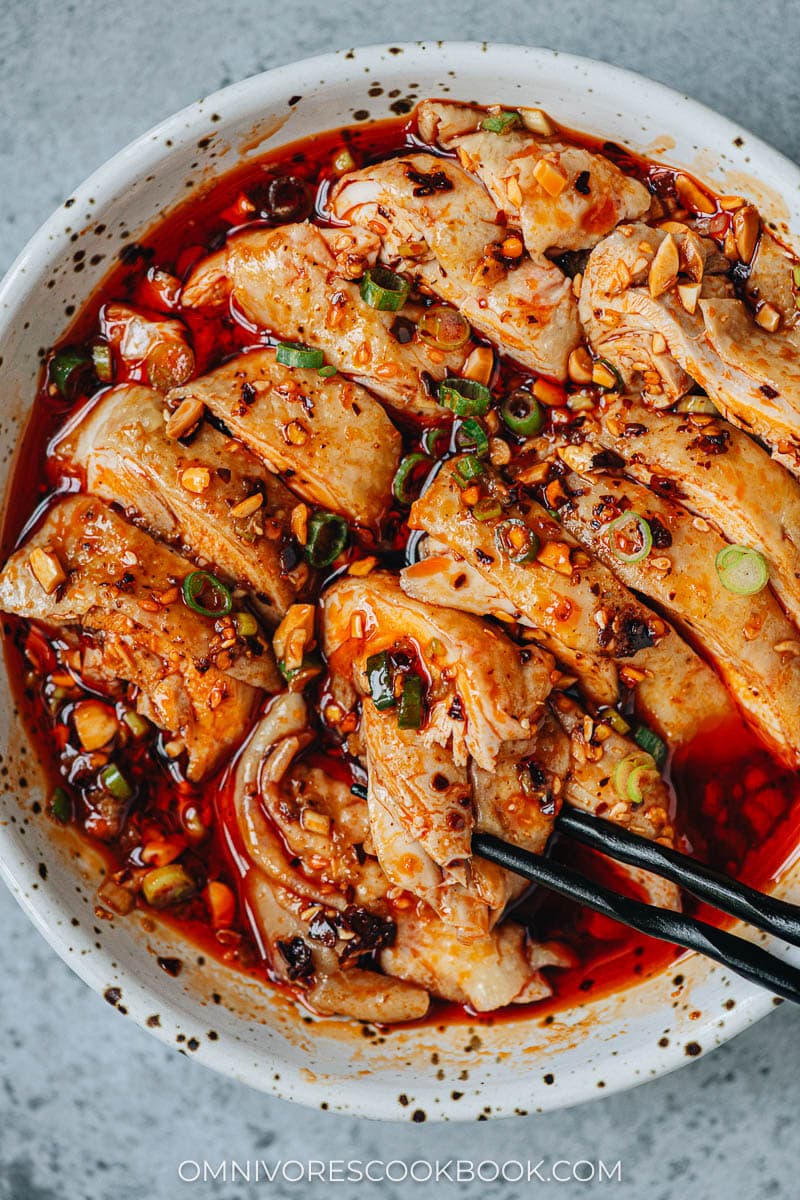
Other important ingredients
The other important ingredients include:
- Shaoxing wine – to add aroma to the chicken
- Fresh ginger – adds fragrance and tenderizes the chicken
- Light soy sauce – adds umami
- Chinkiang vinegar (also called black vinegar) – adds a tangy taste with fermented umami
- Peanuts – Add a crunchy texture
Which cut of chicken should you use?
Authentic saliva chicken usually uses a whole chicken and calls for you to chop it up once it’s cooked and serve it with the bone in and skin on. I opt for bone-in, skin-on thighs to make the recipe more practical for home cooks. I remove the bone once the chicken is cooked, then slice it into thin pieces. If you do not like chicken skin, you can also use boneless, skinless cuts.
I usually do not use chicken breast for this dish, which makes the result less juicy. But if you prefer chicken breast, try to find smaller pieces if possible. When steaming the chicken, check the temperature after 20 minutes. Stop cooking as soon as the internal temperature reaches 165°F (74˚C). It’s very important to not overcook the chicken to keep it very tender.
How to cook saliva chicken
Making saliva chicken is quite easy.
- Rub the chicken with Shaoxing wine and place ginger slices on it.
- Steam the chicken until just cooked through.
- Reserve the juice the chicken released, for making the sauce later.
- Dissolve the sesame paste with the other sauces and aromatics into a smooth paste.
- Add the chili flakes from the chili oil.
- Debone the chicken and slice it once cooled.
- Add the chicken into the sauce and pour the chili oil over the chicken.
- Top with chopped peanuts and enjoy!
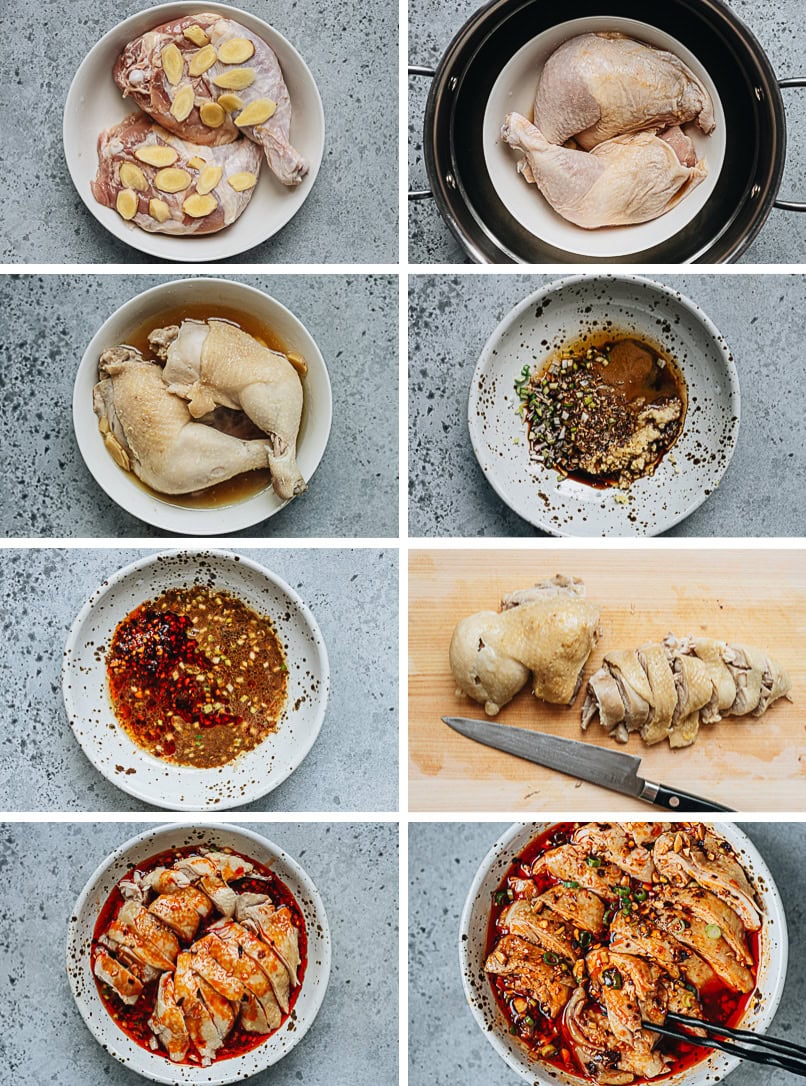
Saliva chicken is a great dish to prepare ahead of time and serve later. When the chicken sits in the sauce, it absorbs the flavor and will become even tastier after a few hours. If you prefer the bright red appearance, you can drizzle the chili oil right before serving.
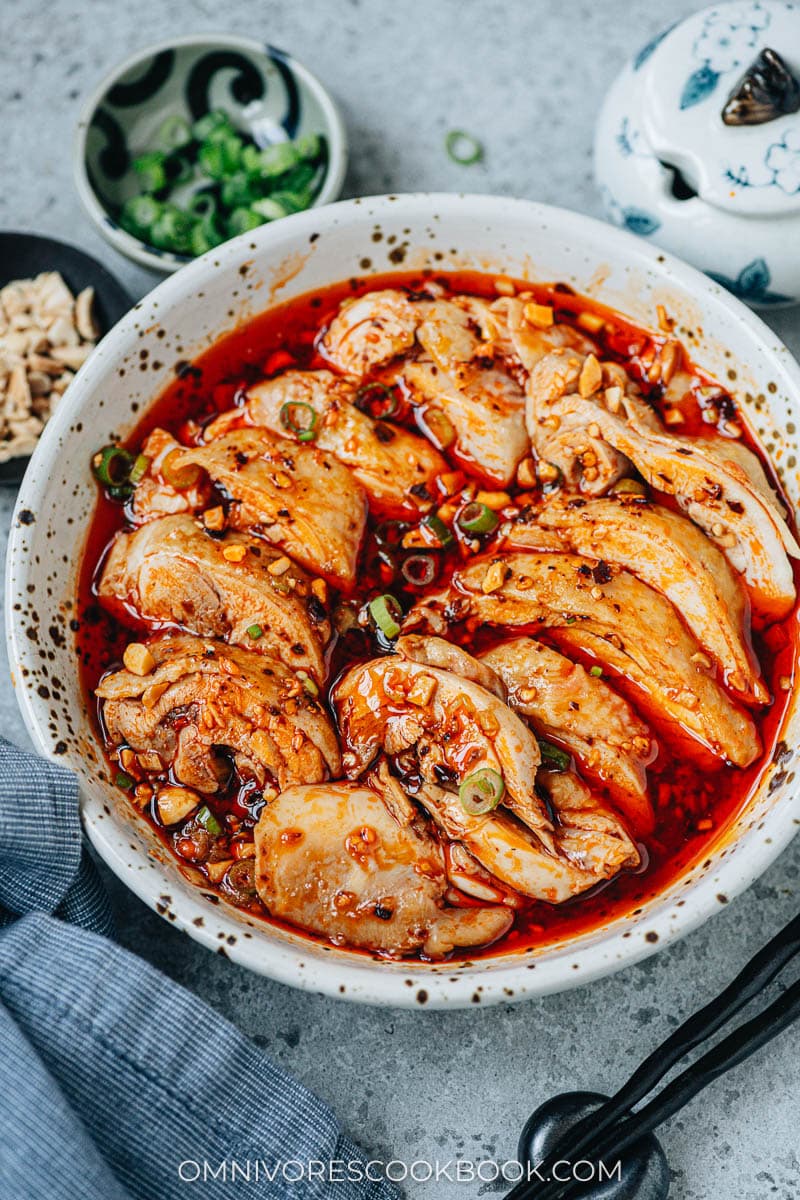
How to serve saliva chicken
Saliva chicken is a cold appetizer dish in Sichuan cuisine. In restaurants, it’s always served at the beginning of a meal. When serving at home, you can serve it with some mains, sides and a soup. I sometimes also serve it as a main dish. The sauce is super rich and tastes great either paired with rice or noodles. In a restaurant setting, the leftover sauce is tossed away. At home, I would dip some noodles into it and make a satisfying meal!
When serving saliva chicken, make sure to pair less spicy / non-spicy food alongside it, to balance the meal and clean your palette.
For a full-on Sichuan dinner, here are some dishes that go well together:
Other delicious chicken recipes
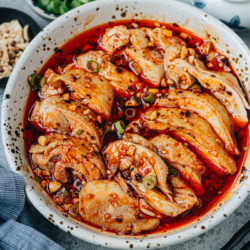
Sichuan Chicken in Red Oil Sauce (Saliva Chicken)
Servings: 2 to 4 servings
Ingredients
Chicken
- 2 (1 to 1.5 lbs / 450 to 680g) bone-in skin-on chicken legs (*Footnote 1)
- 1 thumb ginger sliced
- 2 tablespoons Shaoxing wine (or dry sherry)
- 1/2 teaspoon salt
Instructions
-
Prepare a plate large enough to fit the chicken and small enough to fit into your steamer basket. Evenly spread the ginger slices evenly onto the meat side of the chicken. Then place the chicken onto the prepared plate, skin side up. Pour the Shaoxing wine over the chicken and sprinkle evenly with the salt.
-
Prepare the steamer by heating 2” (5 cm) water in the pot to a boil. Then place the plate with the chicken onto the steamer basket, and place the basket onto the steamer. Steam covered over medium-high heat until the chicken is just cooked through, 30 minutes or so. You can test the doneness by inserting a knife into the thickest part and checking whether the juice runs clear. If it’s clear, the chicken is cooked. Transfer the plate onto your kitchen counter to let the chicken cool off. Reserve the juice from cooking the chicken.
-
Mix the light soy sauce, Chinkiang vinegar, sesame paste, sesame oil, sugar, white part of the green onion, garlic, ginger and ground Sichuan peppercorn in a medium bowl that you plan to serve the chicken. Mix well until the sesame paste is evenly distributed. Add 3 tablespoons of the broth from cooking the chicken, and 1 tablespoon of the chili flake residue from the chili oil. Stir to mix well.
-
When the chicken is cooled, transfer the chicken onto a cutting board. Remove the bones using a paring knife, then slice chicken into 1/2” (1-cm) pieces. Transfer chicken into the bowl with the sauce ingredients.
-
Pour the chili oil over the chicken, and garnish with peanuts and green onion. Serve at room temperature as an appetizer. Stir gently to mix the chicken with the sauce and the chili oil when eating.
Video
Nutrition
Serving: 1serving, Calories: 290kcal, Carbohydrates: 19.4g, Protein: 12g, Fat: 19.7g, Saturated Fat: 3.2g, Cholesterol: 22mg, Sodium: 400mg, Potassium: 312mg, Fiber: 1.5g, Sugar: 2g, Calcium: 97mg, Iron: 2mg

